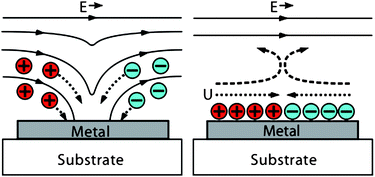Induced-charge electrokinetics: fundamental challenges and opportunities†
Abstract
Induced-charge electrokinetic (ICEK) phenomena occur when an applied electric field induces an ionic double-layer over a polarizable surface, then forces that induced double-layer into electro-osmotic flow. The nonlinear character of ICEK phenomena enable steady flows to be driven using small AC potentials, which in turn reduces or eliminates electrochemical reactions. As such, ICEK holds promise as a mechanism by which low-voltage, high-pressure pumps may be developed to enable portable, self-contained microfluidic manipulation. Here we review the basic physics of induced-charge electrokinetic phenomena and the advantages they hold for Lab-on-a-Chip devices, in addition to the opportunities they present for fundamental science. In particular, these systems are unique in that all aspects of the (measurable) ICEK flows can be predicted in advance using standard electrokinetic theories, which can then be compared with

- This article is part of the themed collection: Fundamental Principles and Techniques in Microfluidics

 Please wait while we load your content...
Please wait while we load your content...